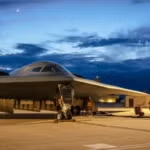
The U.S. Air Force is developing two digitally engineered satellites--so-called "eSats"--and has flown a full-scale demonstrator of its Next-Generation Air Dominance (NGAD) fighter, service acquisition chief Will Roper told the Air Force Association virtual Air, Space, and Cyber (vASC) conference on Sept. 15. "Within the [U.S.] Space Force, we're already working on the first two eSats, hoping to bring this technology into space," he said. "The full scale [NGAD] flight demonstrator has already flown...and it's broken a lot of records…














